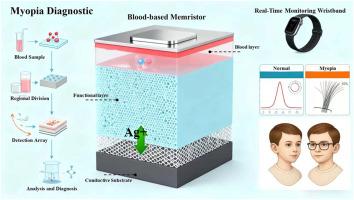An innovative diagnostic method for myopia using blood-based biomemristor
IF 10.2
1区 医学
Q1 ENGINEERING, BIOMEDICAL
引用次数: 0
Abstract
Myopia has become one of the main factors affecting the healthy growth of adolescents. However, the current methods for diagnosing myopia based on physiological indicators are still blank. In this work, a memristive device with Ag/ZIF-8:PVP/FTO structure was developed using ZIF-8 as the main functional material for detecting and distinguishing physiological states associated with high myopia. We observe the as-prepared memristor exhibits a significant I-V curve with memristive characteristics, as well as stable bipolar resistance switching and voltage dependent multi mechanism conduction behavior. Furthermore, after optimizing the system parameters, a robust multi-level switching response was achieved, in which the biomemristor manufactured from blood samples of highly myopic patients showed atypical memory blockade, indicating an interruption in ions migration and trap state dynamics. In particular, the experiment using a monozygotic twin family model has shown that altered memristive behavior is closely related to phenotypic differences rather than genetic identity, highlighting the sensitivity of the device to subtle physiological changes. Therefore, this work has achieved for the first time the application of the memristor based on ZIF-8 in myopia detection, which brings great hope for early screening, phenotype stratification, and minimally invasive monitoring of pediatric and high-risk populations.

一种基于血液的生物反射镜诊断近视的创新方法
近视已成为影响青少年健康成长的主要因素之一。然而,目前基于生理指标的近视诊断方法仍是空白。本文以ZIF-8为主要功能材料,研制了一种具有Ag/ZIF-8:PVP/FTO结构的记忆装置,用于检测和识别高度近视相关的生理状态。我们观察到所制备的忆阻器具有明显的I-V曲线和忆阻特性,以及稳定的双极电阻开关和电压依赖的多机制导通行为。此外,在优化系统参数后,实现了鲁棒的多级开关响应,其中由高度近视患者血液样本制成的生物电阻显示出非典型的记忆阻断,表明离子迁移和陷阱状态动力学中断。特别是,使用单卵双胞胎家庭模型的实验表明,改变的记忆行为与表型差异密切相关,而不是遗传身份,突出了该设备对细微生理变化的敏感性。因此,本工作首次实现了基于ZIF-8的忆阻器在近视检测中的应用,为儿童及高危人群的早期筛查、表型分层、微创监测带来了很大的希望。
本文章由计算机程序翻译,如有差异,请以英文原文为准。
求助全文
约1分钟内获得全文
求助全文
来源期刊

Materials Today Bio
Multiple-
CiteScore
8.30
自引率
4.90%
发文量
303
审稿时长
30 days
期刊介绍:
Materials Today Bio is a multidisciplinary journal that specializes in the intersection between biology and materials science, chemistry, physics, engineering, and medicine. It covers various aspects such as the design and assembly of new structures, their interaction with biological systems, functionalization, bioimaging, therapies, and diagnostics in healthcare. The journal aims to showcase the most significant advancements and discoveries in this field. As part of the Materials Today family, Materials Today Bio provides rigorous peer review, quick decision-making, and high visibility for authors. It is indexed in Scopus, PubMed Central, Emerging Sources, Citation Index (ESCI), and Directory of Open Access Journals (DOAJ).
 求助内容:
求助内容: 应助结果提醒方式:
应助结果提醒方式:


